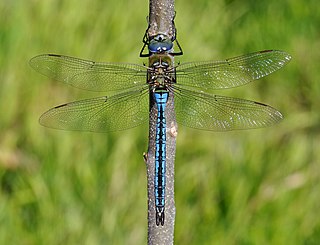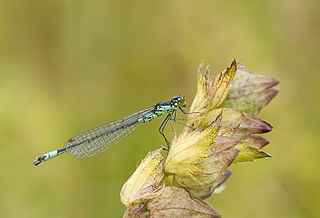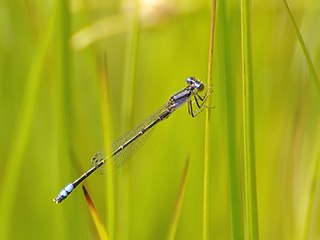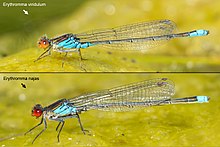
A dragonfly is a flying insect belonging to the infraorder Anisoptera below the order Odonata. About 3,000 extant species of dragonflies are known. Most are tropical, with fewer species in temperate regions. Loss of wetland habitat threatens dragonfly populations around the world. Adult dragonflies are characterized by a pair of large, multifaceted, compound eyes, two pairs of strong, transparent wings, sometimes with coloured patches, and an elongated body. Many dragonflies have brilliant iridescent or metallic colours produced by structural coloration, making them conspicuous in flight. An adult dragonfly's compound eyes have nearly 24,000 ommatidia each.

Damselflies are flying insects of the suborder Zygoptera in the order Odonata. They are similar to dragonflies but are smaller and have slimmer bodies. Most species fold the wings along the body when at rest, unlike dragonflies which hold the wings flat and away from the body. Damselflies have existed since the Jurassic, and are found on every continent except Antarctica.

The red-veined darter or nomad is a dragonfly of the genus Sympetrum.

The emperor dragonfly or blue emperor is a large species of hawker dragonfly of the family Aeshnidae. It is the bulkiest dragonfly in most of Europe, including the United Kingdom, although exceeded by the magnificent emperor and in length by females of the golden-ringed dragonfly.

The common darter is a dragonfly of the family Libellulidae native to Eurasia. It is one of the most common dragonflies in Europe, occurring in a wide variety of water bodies, though with a preference for breeding in still water such as ponds and lakes. In the south of its range adults are on the wing all year round.

The banded demoiselle is a species of damselfly belonging to the family Calopterygidae. It is often found along slow-flowing streams and rivers. It is a Eurasian species occurring from the Atlantic coast eastwards to Lake Baikal and northwestern China.

The blue-tailed damselfly or common bluetail is a damselfly, belonging to the family Coenagrionidae.

The arroyo bluet is a damselfly of the family Coenagrionidae, native to the western United States, south to southern Mexico. It is associated with slow-flowing streams or lake margins with emergent vegetation.

The blue-eyed darner is a common dragonfly of the family Aeshnidae; native to the western United States, it is commonly sighted in the sagebrush steppe of the Snake River Plain, occurring east to the Midwest from central Canada and the Dakotas south to west Texas and Oklahoma. In Central America it occurs south to Panama. This is usually the second earliest darner to emerge in the spring, with the California darner emerging first. It hunts small flying insects while on the wing.

Erythromma najas, the red-eyed damselfly, is a member of the Coenagrionidae family of damselflies.

The Norfolk damselfly or dark bluet is a species of blue damselfly of the family Coenagrionidae native to Eurasia.

The small red damselfly is a small damselfly flying in heathland bogs and streams. It is in the family Coenagrionidae.

The white-legged damselfly or blue featherleg is a damselfly of slow-flowing, muddy waters. It occurs from the Atlantic to Siberia and is often abundant throughout its range.

The ebony jewelwing is a species of broad-winged damselfly. One of about 150 species of Calopterygidae, it is found in the eastern U.S. and southeastern Canada, ranging west to the Great Plains. Other common names include black-winged damselfly.

Lestes praemorsus is a damselfly species in the family Lestidae. It is commonly known as the scalloped spreadwing or sapphire-eyed spreadwing. It is very widely distributed from India to China and south to New Guinea.

Chalcolestes viridis, formerly Lestes viridis, is a damselfly of the family Lestidae. It has a metallic green body and at rest it holds its wings away from its body. Its common name is the willow emerald damselfly, the green emerald damselfly, or the western willow spreadwing. It has an elongated abdomen and pale brown spots on its wings and resides in areas of still water with overhanging trees.

Proischnura polychromatica, the mauve bluet, is a small species of damselfly in the family Coenagrionidae. It is endemic to a small area of Cape Province in South Africa. The adult male has a mauve sheen to its dark-coloured body, a bronze-green thorax striped with mauve, and a pale brown abdomen with a bronze-green dorsal stripe. The female is mainly pale brown. The natural habitat of this damselfly is transient pools in stream beds with floating vegetation, especially sedges. Although previously more widespread, it is now known from a single location where it is threatened by the encroachment of cattle and the loss of suitable habitat. For these reasons, the International Union for Conservation of Nature has rated it as "endangered".

Ischnura erratica, the swift forktail, is a species of damselfly in the family Coenagrionidae. It is native to the Pacific Northwest, ranging from British Columbia to northern California.
Neoneura amelia, commonly known as Amelia's threadtail, is a species of damselfly in the family Coenagrionidae. It is native to the southern United States and Central America, its range extending from the southern tip of Texas to Panama.




















